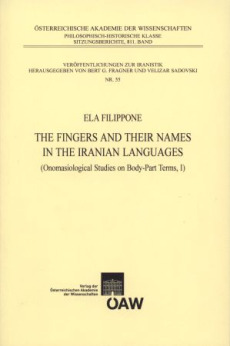Ela Filippone
The Fingers and their Names in the Iranian Languages (Onomasiological Studies on Body-Parts Terms, I)
Reihe: Sitzungsberichte der philosophisch-historischen Klasse, Veröffentlichungen zur IranistikThe present volume contains an analysis in a motivational perspective of all the words for “finger” and the names of individual fingers in the Iranian languages, both ancient and modern, according to the lines of modern onomasiology. It also contains several cross-linguistic semasiological digressions with occasional sorties in conceptual domains other than finger. After a general introduction (chapter one), where the position of the human hand and fingers in human imagery, their ordinary functions, their symbolic value, their role in substaining devotional and ideological systems, their capacity to communicate, etc. are commented , the relevant words and expressions, grouped according to their iconomastic type, and inside these groupings, to their etymons, are discussed in the chapters two to seven, devoted to the general terms for finger and the names for thumb, forefinger, middle finger, etc. Looking for the “pathways” through which the fingers have been conceptualized and verbalized, and going back (when possible) to the original source concepts, many regularities in the recurrent schemas have been proved to exist, some of which are universal, being present not only in Iranian or areally connected languages, but also in languages not related at all. A comprehensive word-index closes the volume.
The present book, which follows the publication of the volume The Pupil of the eye in the Iranian languages (1995) by the same author, represents the first issue of an editorial project on the Iranian languages (Onomasiological Studies on Body-Part Terms), aimed at the diffusion of the results of a long-term research which has produced over the years a database including several thousands of Iranian words and expressions relevant to the body part lexical domain. For this purpose, the author has used sources often difficult to trace in Europe such as dictionaries, glossaries, dialectal literature and running texts, and for some languages (as Persian, Balochi, Baxtiari, Kurdish, Ossetic, etc.), also spoken texts recorded in different environments by native speakers.
